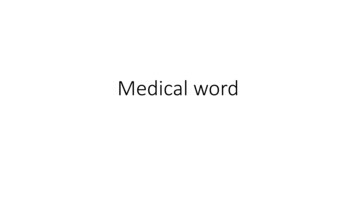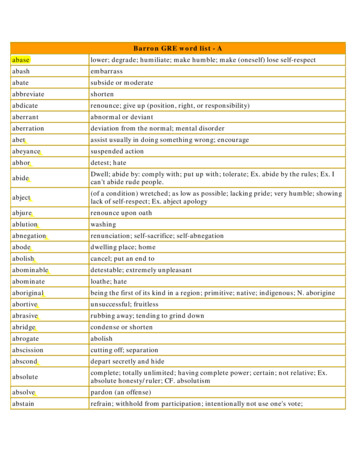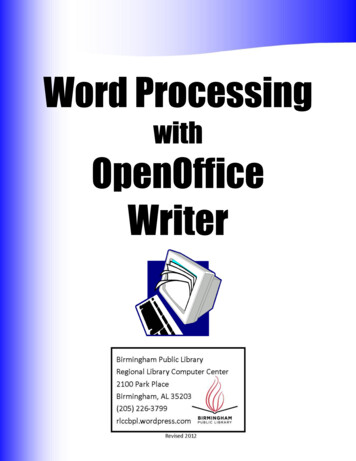
Transcription
Welcome to Word Ladders!In this book you’ll find 100 mini-wordstudy lessons that are also kid-pleasinggames! To complete each Word Laddertakes just ten minutes but actively involveseach learner in analyzing the structure andmeaning of words. To play, students beginwith one word and then make a series ofother words by changing or rearranging theletters in the word before. With regular use,Word Ladders can go a long way towarddeveloping your students’ decoding andvocabulary skills.that all children need to do in order tolearn how to decode and spell accurately.And when the puzzle adds a bit of meaningin the form of a definition (for example,“make a word that means to saysomething”), it helps extend students’understanding of words and concepts.All of these skills are key to students’success in learning to read and write. Soeven though Word Ladders will feel likea game your students will be practicingessential literacy skills at the same time!How do Word Ladders work?Let’s say our first Word Ladder begins withthe word walk. The directions will tellstudents to change one letter in walk tomake a word that means “to speak.” Theword students will make, of course, is talk.The next word will then ask students tomake a change in talk to form anotherword—perhaps chalk, or tall. At the top ofthe ladder, students will have a final wordthat is in some way related to the firstword—for example, run. If students getstuck on a rung along the way, they cancome back to it, because the words beforeand after will give them the clues theyneed to go on.How do Word Ladders benefitstudents?Word Ladders are great for buildingstudents’ decoding, phonics, spelling, andvocabulary skills. When students add orrearrange letters to make a new wordfrom one they have just made, they mustexamine sound-symbol relationshipsclosely. This is just the kind of analysisNameRead the clues, then writethe words.Start at the bottom andclimb to the top.ma n y10A male person olderthan a boy.Change one letter.9t a n8Number of fingersa person has.Change one letter.76m e nA chicken wholays eggs.Change one letter.5m e ow4To cut grass.Change one letter.A light brown color.Change one letter.t e nh e nMore than one man.Take away twoletters, then addone more.More than a few.Add one letter.ma nSound made by a cat.Add one letter.mow3n ow2Opposite of old.Change one letter.In the present time.Change one letter.n e w1f e w7How do I teach a Word Ladder lesson?Word Ladders are incredibly easy and quickto implement. Here are four simple steps:1. Choose a Word Ladder to try. (The firstfive pages feature easier ladders; youmay want to start with those.)2. Make a copy of the Word Ladder foreach student.3. Choose whether you want to do yourWord Ladders with the class as a whole,or by having students work alone, inpairs, or in groups. (You might do the5
first few together, until students areready to work more independently.)4. At each new word, students will seetwo clues: the kinds of changes theyneed to make to the previous word(“rearrange letters” or “add two letters”),and a definition of or clue to themeaning of the word. Sometimes thisclue will be a sentence in which theword is used in context but is left outfor children to fill in. Move from wordto word this way, up the whole WordLadder.Look for the Bonus Boxes withstars. These are particularly difficultwords you may want to preteach.Or you can do these ladders as agroup so that children will not getstuck on this rung.That’s the lesson in a nutshell! It shouldtake no longer than ten minutes to do.Once you’re done, you may wish to extendthe lesson by having students sort thewords into various categories. This canhelp them deepen their understanding ofword relationships. For instance, theycould sort them into: Grammatical categories. (Which wordsare nouns? Verbs?) Word structure. (Which words have along vowel and which don’t? Whichcontain a consonant blend?) Word meaning. (Which words expresswhat a person can do or feel? Whichdo not?)6Tips for WorkingWith Word LaddersTo give students extra help, mixup and write on the board all the“answers” for the ladder (that is, thewords for each rung) for them tochoose from as they go through thepuzzle. In addition: Add your own clues to give studentsextra help as they work througheach rung of a ladder. A recent eventin your classroom or communitycould even inspire clues for words. If students are having difficulty witha particular word, you might simplysay the word aloud and see ifstudents can spell it correctly bymaking appropriate changes in theprevious word. Elaborate on themeanings of the words as studentsmove their way up the ladder. If students are stuck on a particularrung of the Word Ladder, tell themto skip it and come back to it later. Challenge students to come up withalternative definitions for the samewords. Many words, like lock, fall,and stock, have multiple meanings.Timothy Rasinski is a professor of literacyeducation at Kent State University, with aspecial focus on young and strugglingreaders. Dr. Rasinski has served on theboard of directors at the InternationalReading Association and as president of theCollege Reading Association. He is theauthor of numerous books and professionalarticles on effective reading instruction.
NameRead the clues, then write the words.Start at the bottom and climb to the top.Little.Add one letter.6A shopping center.Change one letter.542To have lightedsomething.Take awaythree letters.1l i t t l e10Giveto me.Take awayone letter.Scholastic Teaching Resources3Daily Word Ladders Grades 2–3Sick.Take away oneletter, thenadd two.A machine that grindspepper is called apepper.Add one letter.
NameRead the clues, then write the words.Start at the bottom and climb to the top.It falls from the skyand makes you wet.Add one letter.1110Part of the wheatplant.Change one letter.98The opposite of good.Change one letter.Scholastic Teaching ResourcesDaily Word Ladders Grades 2–3You wear it to hold upyour pants.Change one letter.32All of us.Take away one letter.A stick used forhitting balls.Change one letter.54Something that makesa ringing noise.Change one letter.Short for Bradley.Add one letter.76A wager or guess thatsomething will happen.Take away one letter.Walked very fast.Take away one letter.Healthy.Add two letters.1we t11
NameRead the clues, then write the words.Start at the bottom and climb to the top.109876Not short.Change one letter.54To get or bringsomething.Change one letter.1t e am12A story.Change one letter.32Food that comesfrom animals.Rearrange letters.What you pay tocross a bridge.Change one letter.Not wild. A house petis.Rearrange letters.Scholastic Professional BooksAn enormous weight:2,000 pounds.Take away two letters,then add one.Ripped.Add one letter.Daily Word Ladders, Grades 2–3Something getsout when it has beenused often.Change one letter.What teams must dotogether. The coach saidto us, “Good, team!”Change one letter.
NameRead the clues, then write the words.Start at the bottom and climb to the top.Another season.Change oneletter.98More slim.Add two lettersand rearrange.76Thin and narrow,not wide or thick.Take away twoletters, thenadd one.Scholastic Teaching ResourcesDaily Word Ladders Grades 2–3A bandage thathangs from theneck to support ahurt arm.Add one letter.32A cord or thread.You put beads onato make anecklace.Change oneletter.A thick andgooey liquid.Add one letter.54To make music withyour voice.Take away oneletter.To heat somethingto just below theboiling point.Take away oneletter.Something abee does.Take away oneletter.1s p r i n g13
NameRead the clues, then write the words.Start at the bottom and climb to the top.9876The past tense of sit.Hein the chair.Take away oneletter.54A house pet that isrelated to lionsand tigers.Change one letter.1a r t14A word you mightsay to make ananimal go away.Add one letter.32A two-wheeled vehiclefor carrying things.Add one letter.A tool used to cutwood.Change one letter.An automobile.Take awayone letter.Scholastic Teaching ResourcesNot cooked.Change one letter.A thing used tosuck a drinkfrom a glass.Add two letters.Daily Word Ladders Grades 2–3To make pictures.Take away twoletters, then add one.
NameRead the clues, then write the words.Start at the bottom and climb to the top.A short rest.Change one letter.1110To hit.Change one letter.Children often sit ontheir parents’s.Rearrange theletters.98Scholastic Teaching ResourcesDaily Word Ladders Grades 2–3Baby birds makethis sound.Take away twoletters, thenadd one.A friend.Take awayone letter.54To take off the skinof an orange.Change one letter.32To flow ortrickle slowly.Take awayone letter.To make applause.Add one letter.76Another name fora bucket.Change two letters.A liquid thatcomes from trees.Take away oneletter.An animal thatgives us wool.Add one letter.1s l e e p15
NameRead the clues, then write the words.Start at the bottom and climb to the top.Opposite of most.Add one letter.987654A wooden barrel thatholds liquids.Change one letter.32The pole on a sailboatthat holds the sails.Change one letter.1mo s t16What a doctor puts onyour arm or leg if it’sbroken.Change one letter.This covers your faceon Halloween.Change one letter.Scholastic Teaching ResourcesThe land next tothe sea.Add one letter.The price ofsomething.Take awayone letter.Daily Word Ladders Grades 2–3If something can’tbe found, it’s.Change one letter.Opposite of first.Change oneletter.
How do Word Ladders work? Let’s say our first Word Ladder begins with the word walk. The directions will tell students to change one letter in walkto make a word that means “to speak.” The word students will make, of course, is talk. The next word will then ask students to make a change in talkto form another word—perhaps chalk, or tall. At the top of











